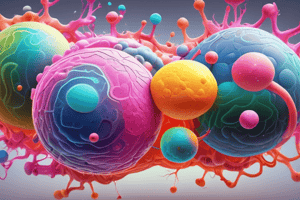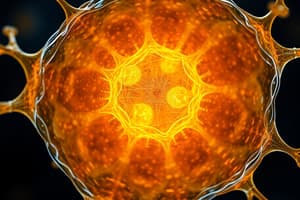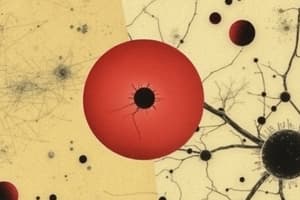Podcast
Questions and Answers
What is the primary function of the nucleolus within a cell?
What is the primary function of the nucleolus within a cell?
- Protein synthesis
- Ribosome production (correct)
- Energy production
- Waste breakdown
Which structure is responsible for the production of ATP?
Which structure is responsible for the production of ATP?
- Lysosome
- Mitochondrion (correct)
- Granular Endoplasmic Reticulum
- Smooth Endoplasmic Reticulum
What distinguishes the granular endoplasmic reticulum from the smooth endoplasmic reticulum?
What distinguishes the granular endoplasmic reticulum from the smooth endoplasmic reticulum?
- Presence of ribosomes (correct)
- Location in the nucleus
- Involvement in lipid synthesis
- Function in waste breakdown
The primary function of lysosomes is to:
The primary function of lysosomes is to:
What is the primary composition of the cell membrane?
What is the primary composition of the cell membrane?
What is the primary function of the cell membrane?
What is the primary function of the cell membrane?
Which component of the cell membrane provides specificity?
Which component of the cell membrane provides specificity?
What role does cholesterol play in the cell membrane?
What role does cholesterol play in the cell membrane?
Which organelle is responsible for modifying, packaging, and transporting proteins and lipids?
Which organelle is responsible for modifying, packaging, and transporting proteins and lipids?
What primarily makes up the cytoplasm of a cell?
What primarily makes up the cytoplasm of a cell?
Which structure is involved in the formation of microtubules?
Which structure is involved in the formation of microtubules?
Which component of the cell membrane contributes approximately 10% to its structure?
Which component of the cell membrane contributes approximately 10% to its structure?
What defines integral proteins in the cell membrane?
What defines integral proteins in the cell membrane?
What is the primary function of cilia in single-celled organisms like paramecium?
What is the primary function of cilia in single-celled organisms like paramecium?
Which statement correctly describes the composition of a cilium?
Which statement correctly describes the composition of a cilium?
How does ciliary movement occur?
How does ciliary movement occur?
What is the primary function of mitochondria?
What is the primary function of mitochondria?
Which of the following correctly describes the composition of microtubules?
Which of the following correctly describes the composition of microtubules?
What characterizes primary cilia in human cells?
What characterizes primary cilia in human cells?
What is a common function associated with primary cilia?
What is a common function associated with primary cilia?
What structural feature allows the nuclear membrane to be selectively permeable?
What structural feature allows the nuclear membrane to be selectively permeable?
Which statement accurately describes the function of the nucleolus?
Which statement accurately describes the function of the nucleolus?
What initiates the process of receptor-mediated endocytosis?
What initiates the process of receptor-mediated endocytosis?
Which of the following processes involves the engulfing of large particles by a phagocyte?
Which of the following processes involves the engulfing of large particles by a phagocyte?
What is a key role of lysosomes in cellular digestion?
What is a key role of lysosomes in cellular digestion?
What triggers the formation of a vesicle during pinocytosis?
What triggers the formation of a vesicle during pinocytosis?
What is the primary function of the Rough Endoplasmic Reticulum?
What is the primary function of the Rough Endoplasmic Reticulum?
What distinguishes Smooth Endoplasmic Reticulum from Rough Endoplasmic Reticulum?
What distinguishes Smooth Endoplasmic Reticulum from Rough Endoplasmic Reticulum?
What is the role of the Golgi Apparatus in the cell?
What is the role of the Golgi Apparatus in the cell?
Which of the following is NOT a characteristic of lysosomes?
Which of the following is NOT a characteristic of lysosomes?
What is the function of hydrolytic enzymes found in lysosomes?
What is the function of hydrolytic enzymes found in lysosomes?
What distinguishes peroxisomes from lysosomes?
What distinguishes peroxisomes from lysosomes?
What type of secretion involves a specific trigger?
What type of secretion involves a specific trigger?
Lysosomal storage diseases are the result of which of the following?
Lysosomal storage diseases are the result of which of the following?
What happens to the engulfed particles once the phagosome fuses with a lysosome?
What happens to the engulfed particles once the phagosome fuses with a lysosome?
What is the role of clathrin in receptor-mediated endocytosis?
What is the role of clathrin in receptor-mediated endocytosis?
Which of the following is NOT a function of lysosomes?
Which of the following is NOT a function of lysosomes?
Which chemical compound has the largest change in free energy (ΔG) under standard conditions?
Which chemical compound has the largest change in free energy (ΔG) under standard conditions?
What initiates the process of ATP production in cells?
What initiates the process of ATP production in cells?
What is the maximum amount of ATP that can be generated from one molecule of glucose?
What is the maximum amount of ATP that can be generated from one molecule of glucose?
In amoeboid locomotion, what process occurs at the leading edge of the pseudopodium?
In amoeboid locomotion, what process occurs at the leading edge of the pseudopodium?
Which agent contained in lysosomes is responsible for dissolving the bacterial cell wall?
Which agent contained in lysosomes is responsible for dissolving the bacterial cell wall?
Flashcards
Cell Membrane Structure
Cell Membrane Structure
A thin, flexible structure surrounding the cell. Composed mainly of proteins and lipids, arranged in a bilayer.
Cell Membrane Composition
Cell Membrane Composition
Approximately 55% proteins, 25% phospholipids, 13% cholesterol, 4% other lipids, and carbohydrates.
Cell Membrane Components- Lipids
Cell Membrane Components- Lipids
Lipids form a barrier to water-soluble substances, making the membrane selectively permeable.
Cell Membrane Components- Proteins
Cell Membrane Components- Proteins
Signup and view all the flashcards
Integral Proteins
Integral Proteins
Signup and view all the flashcards
Peripheral Proteins
Peripheral Proteins
Signup and view all the flashcards
Cell Membrane Components- Carbohydrates
Cell Membrane Components- Carbohydrates
Signup and view all the flashcards
Cytoplasm
Cytoplasm
Signup and view all the flashcards
Cell Organelles
Cell Organelles
Signup and view all the flashcards
Centrioles
Centrioles
Signup and view all the flashcards
Secretory Granules
Secretory Granules
Signup and view all the flashcards
Microtubules
Microtubules
Signup and view all the flashcards
Nuclear Membrane
Nuclear Membrane
Signup and view all the flashcards
Golgi Apparatus
Golgi Apparatus
Signup and view all the flashcards
Nucleolus
Nucleolus
Signup and view all the flashcards
Glycogen
Glycogen
Signup and view all the flashcards
Ribosomes
Ribosomes
Signup and view all the flashcards
Lysosome
Lysosome
Signup and view all the flashcards
Mitochondrion
Mitochondrion
Signup and view all the flashcards
Granular ER
Granular ER
Signup and view all the flashcards
Smooth ER
Smooth ER
Signup and view all the flashcards
Microfilaments
Microfilaments
Signup and view all the flashcards
Cell Membrane
Cell Membrane
Signup and view all the flashcards
Nuclear membrane
Nuclear membrane
Signup and view all the flashcards
Cytoplasm
Cytoplasm
Signup and view all the flashcards
Membranous structures
Membranous structures
Signup and view all the flashcards
Endoplasmic Reticulum
Endoplasmic Reticulum
Signup and view all the flashcards
Rough ER
Rough ER
Signup and view all the flashcards
Smooth ER
Smooth ER
Signup and view all the flashcards
Golgi Apparatus
Golgi Apparatus
Signup and view all the flashcards
Exocytosis
Exocytosis
Signup and view all the flashcards
Secretory Vesicles
Secretory Vesicles
Signup and view all the flashcards
Lysosomes
Lysosomes
Signup and view all the flashcards
Lysosomal Storage Diseases
Lysosomal Storage Diseases
Signup and view all the flashcards
Peroxisomes
Peroxisomes
Signup and view all the flashcards
Secretory Granules
Secretory Granules
Signup and view all the flashcards
Secretion
Secretion
Signup and view all the flashcards
Phagosome fusion
Phagosome fusion
Signup and view all the flashcards
Lysosome function
Lysosome function
Signup and view all the flashcards
Receptor-mediated endocytosis
Receptor-mediated endocytosis
Signup and view all the flashcards
Clathrin-coated pits
Clathrin-coated pits
Signup and view all the flashcards
Endosome function
Endosome function
Signup and view all the flashcards
ATP Production Steps (Summary)
ATP Production Steps (Summary)
Signup and view all the flashcards
ATP use in cells
ATP use in cells
Signup and view all the flashcards
Amoeboid Locomotion
Amoeboid Locomotion
Signup and view all the flashcards
Mitochondria Function
Mitochondria Function
Signup and view all the flashcards
Mitochondrial Structure
Mitochondrial Structure
Signup and view all the flashcards
Intermediate Filaments
Intermediate Filaments
Signup and view all the flashcards
Microtubules
Microtubules
Signup and view all the flashcards
Thin Filaments
Thin Filaments
Signup and view all the flashcards
Thick Filaments
Thick Filaments
Signup and view all the flashcards
Nuclear Pores Size
Nuclear Pores Size
Signup and view all the flashcards
Nuclear Pores Function
Nuclear Pores Function
Signup and view all the flashcards
Nucleolus
Nucleolus
Signup and view all the flashcards
Receptor-mediated Endocytosis
Receptor-mediated Endocytosis
Signup and view all the flashcards
Lysosomes
Lysosomes
Signup and view all the flashcards
Pinocytosis
Pinocytosis
Signup and view all the flashcards
Phagocytosis
Phagocytosis
Signup and view all the flashcards
Cell Movement Mechanisms
Cell Movement Mechanisms
Signup and view all the flashcards
Cilia Structure
Cilia Structure
Signup and view all the flashcards
Ciliary Movement
Ciliary Movement
Signup and view all the flashcards
Amoeboid Locomotion
Amoeboid Locomotion
Signup and view all the flashcards
Non-motile Cilia (Primary Cilia)
Non-motile Cilia (Primary Cilia)
Signup and view all the flashcards
Study Notes
Cell Organization
- Protoplasm: collective name for all substances within a cell
- Cell membrane encloses the cell
- Cytoplasm surrounds the nucleus
- Nucleoplasm is inside the nucleus
- Nucleus contains the nucleolus
- Nuclear membrane surrounds the nucleolus
Cell Composition
- Protoplasm (of cells)
- Water/Ions: 70-85% of cell mass
Cell Membrane: Bilayer of Phospholipids with Proteins
- Bilayer of phospholipids with proteins
- Extracellular fluid surrounds the cell
- Cytoplasm (the interior of the cell)
- Integral proteins traverse the bilayer
- Peripheral proteins are associated with the surface
Membrane Components: Lipids
- Barrier to water and water-soluble substances
- Organized in a phospholipid bilayer
- Molecules like CO₂, O₂, glucose, urea, and halothane pass through.
- Hydrophilic heads face outward, hydrophobic tails inward
Membrane Components: Proteins
- Provide specificity to the membrane
- Defined by association with the lipid bilayer
- Integral proteins: channels, pores, carriers, enzymes
- Peripheral proteins: inside the cell, help with signal mediation and enzymes
Membrane Components: Carbohydrates
- Glycolipids (approx. 10%)
- Glycoproteins (majority of integral proteins)
- Proteoglycans
- Glycocalyx: Negative charge repels other negative charges, involved in cell-cell interactions
- Acts as receptors for hormones like insulin, plays a role in immune responses
Cholesterol
- Present in membranes in varying amounts
- Generally decreases membrane fluidity and permeability (except in plasma membrane)
- Increases membrane flexibility and stability
Cell Organelles
- Centrioles,
- Secretory granules,
- Microtubules,
- Nuclear membrane,
- Chromosomes and DNA
- Golgi apparatus,
- Cell membrane,
- Nucleolus,
- Glycogen,
- Ribosomes,
- Lysosomes
- Mitochondrion,
- Granular endoplasmic reticulum
- Smooth endoplasmic reticulum
- Microfilaments
Membranous Structures of the Cell
- Cell membrane
- Nuclear membrane
- Endoplasmic reticulum membrane
- Mitochondria membrane
- Lysosomes
- Golgi apparatus
Cell Membrane
- Thin, pliable, elastic structure
- About 7.5-10 nanometers thick
- Composed mostly of proteins and lipids
- Approximate composition: 55% protein, 25% phospholipids, 13% cholesterol, 4% other lipids, and carbohydrates
Cytoplasm and its Organelles
- Cytosol: jelly-like fluid portion in the cytoplasm
- Contains dissolved proteins, electrolytes
- Various dispersed structures: neutral fat globules, glycogen granules, ribosomes, secretory vesicles
- Important organelles: endoplasmic reticulum, Golgi apparatus, mitochondria, lysosomes, peroxisomes
The Endoplasmic Reticulum
- Network of tubular and flat vesicular structures
- Membrane similar to the plasma membrane
- Space inside tubules is the endoplasmic matrix
Rough or Granular ER
- Outer membrane surface covered with ribosomes
- Newly synthesized proteins extruded into the ER matrix
- Proteins are processed, crosslinked, folded, glycosylated (N-linked), cleaved inside the matrix
Smooth ER
- Site of lipid synthesis: phospholipids, cholesterol
- Growing ER membrane buds continually forming transport vesicles which migrate to the Golgi apparatus
The Golgi Apparatus
- Membrane composition similar to smooth ER and plasma membrane
- Composed of 4-or more stacked layers of flat vesicular structures
- Receives transport vesicles from smooth ER
- Substances formed in the ER are processed, phosphorylated, or glycosylated
- Substances concentrated, sorted, and packaged for secretion
Exocytosis
- Secretory vesicles diffuse through cytosol and fuse with the plasma membrane
- Lysosomes fuse with internal endocytotic vesicles
Secretion
- Secretory vesicles release synthesized proteins from Golgi apparatus to fuse with the plasma membrane
- Constitutive secretion occurs randomly
- Stimulated secretion requires a trigger
Lysosomal Storage Diseases
- Absence of one or more hydrolases: not synthesized, inactive, not properly sorted and packaged
- Result: Lysosomes engorged with undigested substrate
- Examples: Acid lipase A deficiency, I-cell disease, Tay-Sachs disease
Lysosomes
- Vesicular organelles formed from Golgi buds
- Contain hydrolytic enzymes (acid hydrolases): phosphatases, nucleases, proteases, lipid-degrading enzymes, lysozymes (bacteria digesting enzymes)
- Responsible for digestion.
Peroxisomes
- Similar physically to lysosomes
- Two major differences: formed by self-replication, contain oxidases
- Function: Oxidize substances (e.g., alcohol)
Secretory Granules
- These are secretory vesicles.
- Function in cells which release substances.
Mitochondria
- Primary function: extraction of energy from nutrients
- Has an outer membrane which encloses an inner membrane (crests) and an outer chamber.
- The matrix contains oxidative phosphorylation enzymes which produce energy.
The Cytoskeleton
- Intermediate filaments: comprised of cell-specific fibrillar proteins
- Microtubules: heterodimers (of alpha and beta tubulin), part of the spindle fibers/axoneme structure
- Thin filaments: F-actin, part of "stress fibers"
- Thick filaments: myosin
The Nuclear Membrane
- Permeated by thousands of nuclear pores
- 100nm in diameter, with functional diameter of 9nm
- Selectively permeable to molecules up to 44,000 MW
Nucleolus
- One or more per nucleus
- Contains RNA and proteins
- Not membrane delimited
- Functions to form granular subunits of ribosomes
Comparison of Animal Cells with Precellular Forms of Life
- Comparison of sizes
Receptor-mediated Endocytosis
- Molecules attach to cell surface receptors; receptors concentrated in clathrin-coated pits
- Receptor binding causes invagination
- ATP-dependent recruitment of actin and myosin
Digestion of Substances in Pinocytotic or Phagocytic Vesicles
- Process by which lysosomes digest substances in vesicles
- The substances are broken down by enzymes after fusing with a lysosome.
Pinocytosis
- Vesicle that engulfs extracellular fluid
Endocytosis
- Active movement of substances into a cell inside membrane-bound vesicles
Phagocytosis
- Specific form of endocytosis in specialized cells (phagocytes)
- Occurs in response to microbes, dead cells, and cellular debris
- Receptors on phagocyte surface bind to particles
- Plasma membrane extensions (pseudopods) surround the particles
- Vesicle forms (phagosome)
- The phagosome fuses with a lysosome to digest enzymes
ATP Production
- Carbohydrates, Glucose, proteins and fats are converted to produce ATP (energy).
- Acetyl CoA is used in step 3 to generate ATP.
The Use of ATP for Cellular Function
- ATP is crucial for cell processes
- It fuels membrane transport, chemical compound synthesis, and mechanical work
Ameboid Locomotion
- Continual endocytosis at the "tail" and exocytosis at the leading edge of the pseudopodium
- Movement facilitated by receptor proteins and actin/myosin interactions (ATP-dependent)
Chemotaxis
- Cell movement influenced by chemical substances
- Movement toward high concentrations
- Movement away from low concentrations
Cilia and Ciliary Movements
- Occurs in airway and fallopian tubes
- Each cilium is made of microtubules: 9 double tubules, 2 single tubules; an outgrowth of basal bodies and covered by membrane; movement is ATP dependent
Mechanism of Ciliary Movement
- Four stages involved in producing ciliary movement.
- Fifth, there are multiple protein arms which are activated by adenosine triphosphate (ATP).
- The double tubule moves in a specific direction to generate movement.
Non-motile Primary Cilia
- Found on nearly every cell type (except red blood cells)
- Non-motile cilia act as antenna
- Involved in chemical and mechanical sensations to coordinate cellular signaling, cell growth, and signal transduction
Studying That Suits You
Use AI to generate personalized quizzes and flashcards to suit your learning preferences.




